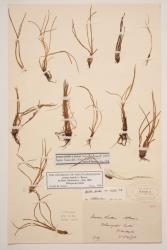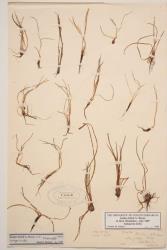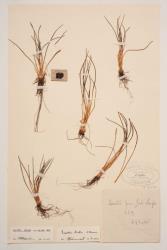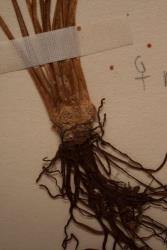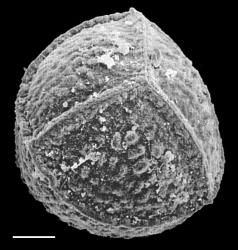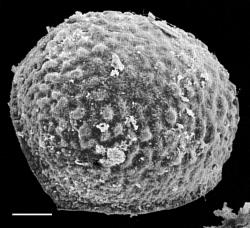- = Isoetes multiangularis Colenso, Trans. & Proc. New Zealand Inst. 22: 449 (1890)
Aquatic, growing submerged, evergreen. Stem short, erect, 1–5 mm tall, or rarely up to 12 mm tall, 2.5–10 mm wide. Leaves in tufts of up to 25, 30–170 mm long, or rarely up to 350 mm long, 0.5–1.5 mm diameter, erect, linear, terete, with conspicuous air chamber; apices long acuminate; margins entire, bases swollen, 3–5 mm wide, broadly winged. Sporangia ovoid, 1.5–6 mm long, 1–3.5 mm wide. Megaspores white, surfaces tuberculate. Microspores echinate.
Isoetes kirkii is generally a smaller, more delicate plant producing tufts of up to 15 leaves, which are shorter and narrower than in I. alpina. The sporangia are also shorter and narrower. I. kirkii is best distinguished by the megaspores, which are white and distinctly tuberculate on their surfaces, in contrast to those of I. alpina, which are grey to white in colour with a smooth surface (Large & Braggins 1991).
North Island: Northland, Auckland, Volcanic Plateau, Southern North Island.
Altitudinal range: 0–350 m.
Isoetes kirkii is circumscribed here as confined to the North Island and known from Lake Ōmāpere, the Wairua River, the Waikato and Rotorua lakes, L. Taupō, L. Pōnui and L. Wairarapa. It has also been recorded from L. Waikaremoana (Hofstra & de Winton 2016), but no specimen has been seen by us, and it is therefore not included on the map. I. kirkii grows from near sea level up to 350 m in L. Taupō. Brunton & Britton also identified plants with tubercled macrospores from L. Onslow (CHR 394977) and L. Te Anau (CHR 480201) in the South Island, but these may be apomictic populations lacking microspores.
Isoetes kirkii grows submerged in shallow lakes, or rarely in slow-moving river water. It has been recorded in water up to 4.1 m deep in L. Taupō (Paul Champion, pers. comm., July 2018).
A possibly distinct taxon from Lake Ōmāpere in Northland was first recognised by Marsden (1979) as "var. flabellata". The name has no standing because it was never published, but Isoetes aff. kirkii (CHR 247118A) from Lake Ōmāpere is treated as a Nationally Critical taxonomically indeterminate taxon (de Lange et al. 2018). It is extinct in the wild but survives in cultivation from material rescued from its last known habitat (de Lange 2011, New Zealand Plant Conservation Network website, http://www.nzpcn.org.nz/flora_details.aspx?ID=860).
Isoetes kirkii is also now extinct in the Waikato Lakes and Wairua River, and is threatened in many of its remaining North Island localities, but is still common in L. Taupō, L. Ōkareka and L. Rotoiti (Paul Champion, pers. comm., July 2018). It is treated as At Risk / Declining by de Lange et al. (2018).
2n = 22 Marsden 1979). There are also unpublished reports of apomictic, tetraploid populations in L. Taupō and L. Rotoiti (see Hofstra et al. 2006).
Isoetes was first collected in New Zealand in February 1869, when it was discovered by F.W. Hutton and Thomas Kirk in the Waikato Lakes region (Kirk 1875). Material was sent to J.D. Hooker at K (001094253), and to von Mueller in Melbourne. It was forwarded to A.C.H. Braun in Berlin, who described it as a new species (Braun 1869), named after Thomas Kirk. The only extant specimen at B collected prior to Braun’s publication is one collected by Kirk in the Waikato area and forwarded by von Mueller in 1869. It is presumed to be the holotype. The only other specimen known to have been collected in 1869 prior to Braun’s publication of I. kirkii is the specimen at K sent to Hooker, but this would not have been seen by Braun. Kirk returned to the Waikato in April 1870 and collected more material, but crucially this was after Braun’s description of the new species.
Isoetes multiangularis was described by Colenso (1890) from material collected at Lake Taupō in 1889 by C.J. Norton. There is no original material in the Colenso herbaria at WELT, K or AK. There is a specimen in WELT (P003753), said to be from the Kirk herbarium, collected by Norton from Lake Taupō in 1889. This may be from the same gathering as the material sent to Colenso, but the specimen is not labelled I. multiangularis, and there is no evidence that Colenso saw it, so it cannot be regarded as original material. The identity of I. multiangularis is therefore uncertain. The name is included here, with considerable doubt, in the synonymy of I. kirkii solely on the basis of its geographic locality, but it could also be one of the apomictic populations thought to occur in the central North Island.
The genetic results that link the South Island populations at Lake Paringa and Lake Ellery with North Island populations of I. kirkii (Hofstra & de Winton 2016) require further investigation. Populations from lakes in the northern South Island have not been sampled, and these areas may be critical for assessing any possible overlap between northern I. kirkii and southern I. alpina .



